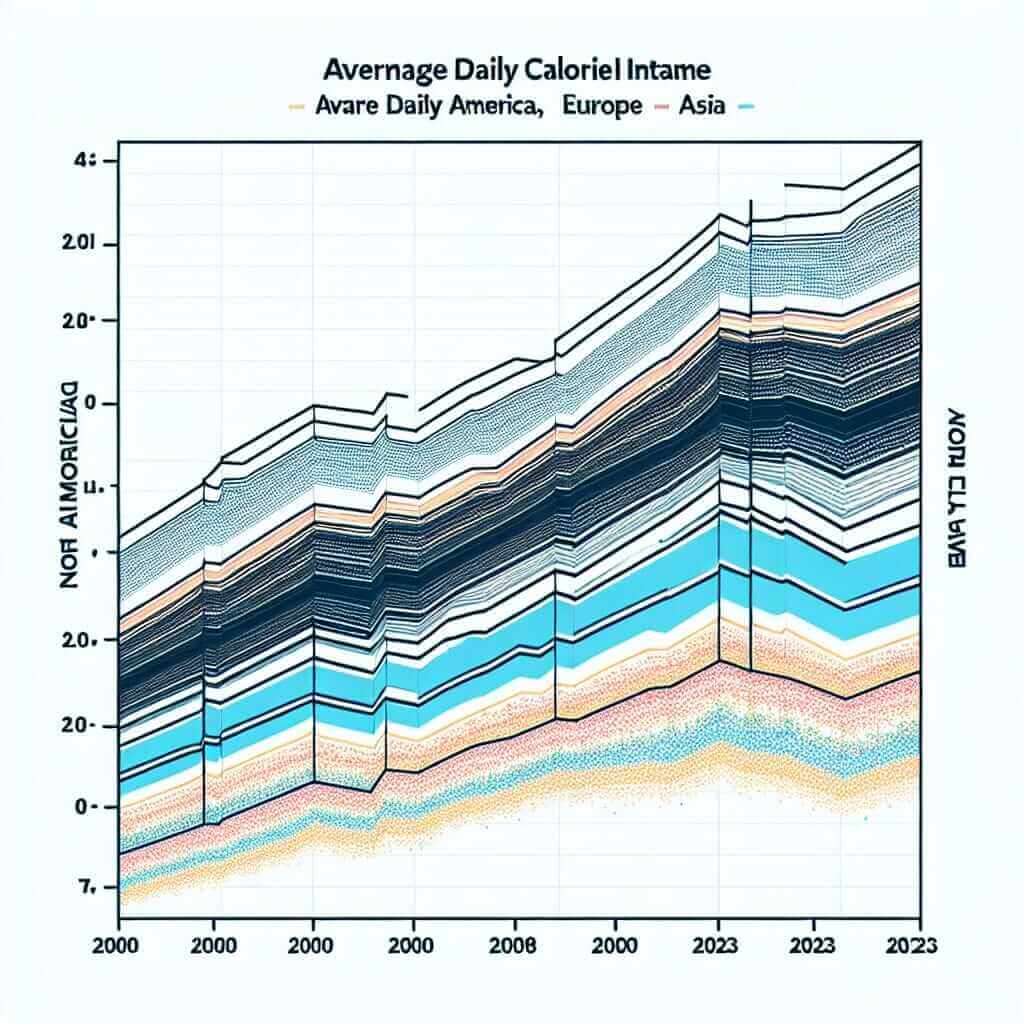The IELTS Writing Task 1 often presents data in various forms, requiring you to accurately interpret and describe the information provided. The topic of “Daily Caloric Intake in Different Regions” is a plausible one, reflecting global health and dietary trends. Let’s delve into how to approach such a task, providing you with the tools to achieve a band 7+ score.
Potential IELTS Writing Task 1 Questions:
- The chart below shows the average daily caloric intake in three different regions (North America, Europe, and Asia) from 2000 to 2023. Summarise the information by selecting and reporting the main features, and make comparisons where relevant.
- The table illustrates the changes in daily caloric intake for different age groups (18-25, 26-45, 46-65, 65+) in a particular region between 2000 and 2023. Write a report for a university lecturer describing the information shown below.
- The line graph compares the daily calorie consumption of men and women in a specific country over two decades (2000-2023). Summarise the information by selecting and reporting the main features, and make comparisons where relevant.
Sample IELTS Writing Task 1 & Model Answer:
Let’s choose the first question for our model answer. Below, you’ll find a table illustrating the average daily caloric intake in three regions: North America, Europe, and Asia from 2000 to 2023. Following the table is a model answer based on this data.
| Region | 2000 | 2005 | 2010 | 2015 | 2020 | 2023 |
|---|---|---|---|---|---|---|
| North America | 3200 | 3300 | 3250 | 3350 | 3400 | 3450 |
| Europe | 2800 | 2850 | 2900 | 2950 | 3000 | 3050 |
| Asia | 2400 | 2500 | 2600 | 2700 | 2800 | 2900 |

Model Answer:
The table presents data on the average daily caloric intake in three distinct geographical regions – North America, Europe, and Asia – over a 23-year period from 2000 to 2023.
Overall, there is a clear upward trend in calorie consumption across all three regions throughout the period in question. North America consistently records the highest intake, followed by Europe and then Asia.
In 2000, North Americans consumed an average of 3200 calories per day, compared to 2800 in Europe and 2400 in Asia. Over the next five years, all regions saw a slight increase, with North American intake rising to 3300 calories, Europe to 2850, and Asia to 2500. This upward trend continued, though at a slower pace, in the following years.
By 2023, the average daily caloric intake in North America reached 3450, while Europe and Asia reached 3050 and 2900 respectively. It is noteworthy that while the gap in calorie consumption between the three regions remained fairly consistent, the overall upward trend suggests a global increase in caloric intake over the two decades.
(Word Count: 169)
Key Takeaways & Tips for IELTS Writing Task 1:
- Understand the data: Before writing, spend time analyzing the provided chart, table, or graph. Identify trends, patterns, and key features.
- Paraphrase the question: Begin your response by paraphrasing the question prompt in your own words. This demonstrates your understanding of the task.
- Overview: Include a concise overview summarizing the main trends or patterns you’ve identified in the data.
- Specific details: Support your overview with specific details and data points from the visual information.
- Comparisons: Where relevant, make comparisons between different data sets, highlighting similarities and differences.
- Accurate language: Use appropriate vocabulary to describe trends (e.g., increase, decrease, fluctuate, remain stable) and make comparisons (e.g., higher than, lower than, similar to).
- Grammar and structure: Employ a range of grammatical structures to showcase your language proficiency. Use clear and concise sentences, and ensure your response is well-organized with paragraphs.
- Proofread carefully: Before submitting, review your work for grammatical errors, spelling mistakes, and clarity.
Vocabulary Focus:
- Intake (noun) /ˈɪn.teɪk/: The amount of something that is taken in by someone or something. Example: Daily caloric intake varies greatly depending on factors like age, activity level, and geographical location.
- Consumption (noun) /kənˈsʌmp.ʃən/: The act of using something, especially food, energy, or fuel. Example: The report examined the trends in food consumption across different income levels.
- Trend (noun) /trend/: A general direction of change or development. Example: The data reveals an upward trend in global calorie consumption.
- Geographical (adjective) /ˌdʒi.əˈɡræf.ɪ.kəl/: Relating to the geography of a particular area. Example: The study analyzed dietary patterns across various geographical regions.
- Consistently (adverb) /kənˈsɪs.tənt.li/: In a way that does not change and continues for a period of time. Example: North America consistently ranked highest in daily calorie consumption.
- Respectively (adverb) /rɪˈspek.tɪv.li/: In the order that has just been mentioned. Example: Europe and Asia averaged 2800 and 2400 calories per day, respectively.
- Noteworthy (adjective) /ˈnoʊtˌwɝː.ði/: Deserving attention because of being important or interesting. Example: It is noteworthy that calorie intake increased across all age groups.
Conclusion:
Mastering the IELTS Writing Task 1 requires a combination of analytical skills, language proficiency, and familiarity with data interpretation. By understanding the structure of the task, practicing with sample questions like those above, and enriching your vocabulary with relevant terms, you’ll be well-equipped to achieve a high band score. Remember to focus on accuracy, clarity, and coherence in your writing, and don’t be afraid to showcase your ability to analyze and interpret data effectively.